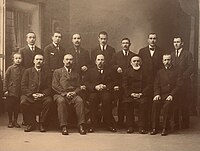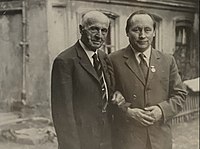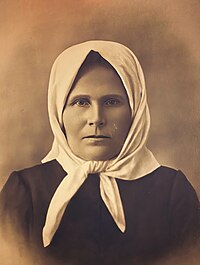| Aisa Hakimcan | |
|---|---|
| Айся Хакимджан Гайсә Хәкимҗан عيسى حكيم جان | |
 Ğaysə Xəkimcan (Kazan, 1970). Ğaysə Xəkimcan (Kazan, 1970). | |
| Born | Айся Хакимжанов عيسى حكيم جان (1896-03-13)13 March 1896 Aktuk, Nizhny Novgorod Governorate, Sergachsky District, Russian Empire |
| Died | 5 November 1972(1972-11-05) (aged 76) Tampere, Finland |
| Resting place | Kalevankangas Cemetery |
| Other names | Aisja Hakimsanoff, Hakimdshan / Hakimsan |
| Organizations | |
| Notable work |
|
| Spouse | Servi سروى |
| Children | Aliye, Reşit |
| Parents |
|
| Relatives | Ümer Sali (uncle) |
| Signature | |
 | |
Aisa Hakimcan /ɑjˈsɑ hɑkimˈd͡ʒan/ (Tatar: Гайсә Хәкимҗан, romanized: Ğaysə Xəkimcan, Tatar pronunciation: [ʁɑj'sæ χækimˈʑɑn] ; 13 March 1896 – 5 November 1972) was a Tatar artist and publisher among the Tatar community of Tampere, Finland. He was known as a nationalistic cultural figure, who directed plays and wrote poetry and met with Idel-Ural politicians Sadri Maksudi and Ayaz İshaki. In 1970 he took part in a conference for the 50th anniversary of Tatarstan in Kazan. His son Räshid Hakimsan (Reşid Hakimcan; 1934–1997) was a hockey player and referee.
Biography

Born as the son of Khakimzhan Mukhametaminov and Maryam Alyautdinova in the Nizhny Novgorod Governorate Mishar village Aktuk, Aisa Hakimcan (Aisya Khakimzhanov) came to Finland in 1917. Like most other Tatars of his generation, Hakimcan made a living as a merchant, but among the Tatar community of Tampere, he was best known as a tough leader and a versatile artist.

Hakimcan was involved in the founding of local Islamic congregation, and later worked at the board. Slightly before this, a short lived predecessor to given congregation was founded and Hakimcan was in a leading position of the project. Hakimcan was also the chairman of The Tampere Turkish Society in late 1940s, and vice chairman multiple times. At the turn of the 1920s, Hakimcan had been one of the Muslims in Tampere, who signed a letter to the imam of Helsinki, urging him to initiate the project of establishing a Tatar congregation.
Among the community Hakimcan was known as a very musical person. He sang, played violin, mandolin and operated as a choir director. Hakimcan also wrote poetry and directed plays named Aliyebanu (Ğaliyəbanu) and Asılyar, both by Mirkhaydar Fayzi. He also acted himself; for example in 1930s, when a play Zöleyha (Zöləyxa) was shown at Tampere Theatre, in honor of guest Ayaz İshaki, who is said to have been very pleased with the performance and "appropriately chosen" actors. (Hakimcan was one of the leads and Turkestan-born Gibadulla Murtasin was the director.) Aliye, the daughter of Aisa, as well as the children of his brother; Zinnetulla, Semiulla, Hamdurrahman and Hafize, all took part in his plays. They were known as a talented family among the Tatars.
The voice of Hakimcan was suitable not only for singing, but also for giving Tarawih prayers during Ramadan, which he recited at his congregation for decades.
His poetry was nationalistic and dealt usually with the feelings of longing for his birthplace. In short, he expressed his feelings in the opening page of his three-part publication, Milli şiğer wə cırlar ( ميللى شيعر وه جرلار; ’National poems and songs’, 1956-1966), as follows:
Belməsəm il dərtləren, min bolay yazmas idem. Millətemne söyməsəm, qulıma qələm almas idem - Translation: "If i did not know the sufferings of my people, i would not express my feelings in writing. I would not take a pen in my hand, if i did not love my people.
The publication consisted of works of the community, collected by Hakimcan. In 1935, Hakimcan wrote that he wished to return to his homeland with "children full of faith", ending the text with İnnə əd-dinə ğinda allahi əl-islam ("Indeed, the religion in the sight of Allah is Islam"; 3:19.). He referred to his people as "Turkish-Tatars" (Törek-tatar xalqı).
Hakimcan printed and published songs and poems with his close friend, imam Habiburrahman Shakir. In 1960s they published a booklet in honor of poet Ğabdulla Tuqay. With businessman Semiulla Wafin, he published a religious work called İslam dine xaq dinder (ايسلام دينى خاق ديندر).

In 1938, a 20-year memorial service for Idel Ural State was held in Warsaw, organized by Tatar activist Ayaz Ishaki. Hakimcan was one of the seven Finnish Tatars who took part in the celebration. Led by the Polish Tatar imam Ali Woronovicz, they visited the tomb of the unknown soldier to honor the deceased fellow Muslims. In June 1970, Hakimcan was invited to Kazan, Tatarstan (TASSR), by Finnish Tatar cultural worker Ymär Daher, as part of the conference on the 50th anniversary of Tatarstan. There they went to the "G. Ibragimov Institute of Language, Literature and Art of the Tatarstan Academy of Sciences", where they were greeted officially. Folklorist Ilbaris Nadirov, who had lectured previously at Tampere, was also present. During the trip, Hakimcan paid a visit to poet Tuqay's grave to show his respects. Magazine "Sotsialistik Tatarstan" (Социалистик Татарстан) published a poem by Hakimcan and briefly interviewed him.
In his 1993 publication Çit illərdəge tatar ədəbiyətı həm matbugatı, Kazan Tatar literary scientist Xatıyp Miñnegulov, who has studied Tatar writers abroad, mentioned a few Finnish Tatars; Xəsən Xəmidulla, Sadri Xəmit, Gəwhər Tuğanay, and also Ğaysə Xəkimcan.
Poem
Üz awılım Yañapar
Qışın mayaq utırtalar
olı yul buylarına.
Yañaparnıñ qızlarına
səlam uğıllarına.
Yəş çağımda küp yöredem
qayınlıqlarında.
Şul cirlərne sağınıp cırlıym
iskə töşkən çağımda.
Yörer idem qırlarında
qaytsam Yañaparıma.
Ber tuyğançı cırlar idem
utırıp yarlarına.
Xətfə kebek yəşel ülən
üsə İsmət tawında.
Taw yulları, qır yulları
bar da bit uylarımda.
Minem söyep eçkən suwım
Mar küpere yanında.
Sarı sazım, Torataşım,
əle də bit küz aldımda.
Yörer idem, menər idem
zur tawnıñ başına.
Tağın ber qat cırlar idem
Basıp qoyaş qarşında.
In his poem "My home village Yañapar" (Aktuk), Hakimcan longs for his birthplace and wishes to return.
This poem was included in a Finnish Tatar paper of Sadri Hamid's, called Ak yul, in 1968.
Versions of name
- Aisja Hakimsanoff (from Russian Айся Хакимжанов, Aisya Khakimzhanov); Hakimdshan / Hakimsan
- Aisa Hakimcan (Standard Tatar: Гайсә Хәкимҗан; Ğaysä Xäkimcan / Ğaysə Xəkimcan; Yaña imlâ: غايسه ھەكيمجان (In Mishar Dialect ğ / غ / г is not pronounced)
- عيسى حكيم جان (İske imlâ)
In modern Russian sources, the surname is spelled Хакимджан (Khakimdzhan), which is a closer equivalent of the Mishar affricate pronunciation . Latin letter c stands for same sound in given dialect.
Given name comes from the Arabic ʿĪsā, which means ”Jesus”. Surname is derived from Arabic al-Ḥakīm (’wise’) and Persian jân (’soul’).
Surname suffix -ov also stands for a patronymic.
Personal life

Aisa was married to a Finnish woman from Nokia, named Sylvia "Särvi" (سروى, Sərwi; 1904–1965). She converted to Islam and was actively involved among the Tatar community with her husband. They had two children; daughter Aliye, who was a talented singer and actress in Tatar language, and a son, hockey player-referee Räshid.
The older brothers of Aisa, Ibrahim and Siddik, as well as his mother, widow of a farmer, Merjam Alautdinoff (Maryam Alyautdinova; 1863–1947) also lived in Finland. Businessman Ymär Sali was the uncle of Aisa. Brother Hasan Hakimsanoff lived in Finland only briefly in early 1900s.
Notes
- Tatar İske imlâ: عيسى حكيم جان (ʿĪsā Ḥakīm Jān)
Russian: Айся Хакимджан (Aisya Khakimdzhan); born Khakimzhanov (Хакимжанов). - In the Mishar Tatar dialect, letter ğ (г) is not pronounced, c (җ) is an affricate and /χæ/ is /хa/.
- The poem was written in Arabic script and here is translated in modern literary (Kazan) Tatar Latin script. Original version includes dialectical peculiarities, such as "kayınçagıllarında" (qayınlıqlarında) and "Tırataş" (Torataş).
References
- ^ Baibulat, Muazzez (2004). The Tampere Islamic Congregation: the Roots and History (in finnish, tatar and english). Jyväskylä: Gummerus Kirjapaino Oy. p. 146. ISBN 952-91-6753-9.
- Leitzinger, Antero (1996). Mishäärit - Suomen vanha islamilainen yhteisö. Helsinki: Kirja-Leitzinger. p. 45. ISBN 952-9752-08-3.
- ^ Halen, Harry (1996). Lahjan Hedelmät (in a book: Tugan Tel - Kirjoituksia Suomen Tataareista, reporter: Kadriye Bedretdin, 2011). Helsinki: Suomen Itämainen Seura. p. 341. ISBN 978-951-9380-78-0.
- Leitzinger 1996, p. 218
- Suikkanen, Mikko. "Yksityinen Susi - Zinetullah Ahsen Bören (1886-1945) eletty ja koettu elämä".
- "Файзи (Файзуллин) Мирхайдар Мустафович".
- Baibulat 2004, pp. 190, 192.
- ^ Baibulat 2004, p. 190, 192.
- Baibulat 2004, pp. 183-184
- Aisa Hakimcan: "Tampere töreklär berlege" (Tampere, 1935)
- "Abdulla Tukay | Kansalliskirjasto". Finna.fi.
- Baibulat, Muazzez (2004). The Tampere Islamic Congregation: the roots and history. Jyväskylä: Gummerus Kirjapaino Oy. p. 114. ISBN 952-91-6753-9.
- Minnullin K.M., O.R. Khisamov & M.I. Ibragimov (eds) 2019. Institut yazyka, literatury i isskustva imeni G. Ibragimova . Kazan: Institut yazyka, literatury i isskustva imeni G. Ibragimova.
- Baibulat 2004, p. 158
- Sotsialistik Tatarstan" (June 28. 1970, p. 2)
- З.Г. Гарипова: Мөһаҗирлектәге татарларның милли-мәдәни тормышы
- Миңнегулов Х. Чит илләрдәге татар әдәбияты һәм матбугаты. Казан утлары, 1993, №7.
- Baibulat, Muazzez: Tampere Habärläre. May 2010 (p. 5)
- Hamid, Sadri: Ak yul, issue 3: Oulu 1968 (p. 2)
- Беляев, Рамиль: Татары Финляндии – история, интеграция, сохраненне идентичности. Казань, 2019. ISBN 978-5-6043753-3-4 (p. 152)
- Leitzinger 1997, p. 45
- Halen, Harry (1996). Lahjan hedelmät (in a book called Tugan Tel: Kirjoituksia Suomen Tataareista, reporter: Kadriye Bedretdin, 2011). Suomen Itämainen Seura. p. 346. ISBN 978-951-9380-78-0.
- "01.12.1935 Tampereen osoitekalenteri No. 1936".
- "ТАТАР ИР-АТ ИСЕМНӘРЕ (ТАТАРСКИЕ МУЖСКИЕ ИМЕНА В АЛФАВИТНОМ ПОРЯДКЕ)". Archived from the original on 2022-10-27. Retrieved 2022-05-26.
- Kamal, Kärim (2006). "Könbatış xristiannarı Pasxanı bilgeli, yaña Papa üzeneñ berençe "Urbi et Orbi" yullamasın yasadı".
- Jazyki Rossijskoi Federatsii i sosednih gosudarstv. Tom 3, s. 67–68. Moskva: Nauka, 2005. ISBN 5-02-011237-2.
- Leitzinger p. 45 (1996)
- "TATAR: Table of Correspondences, Cyrillic - Roman" (PDF). Archived from the original on 2014-11-23. Retrieved 2022-12-13.
{{cite web}}: CS1 maint: bot: original URL status unknown (link) - "Хакимзян".
- "Revizskaya skazka 1858 Aktukovo".
- "Tatar language alphabet"" (PDF).
- Ilya, Karl, Nurlan, Yevlampiev, Pentzlin, Joomagueldinov (2011). "Revised Proposal to encode Arabic characters used for Bashkir, Belarusian, Crimean Tatar, and Tatar languages" (PDF).
{{cite web}}: CS1 maint: multiple names: authors list (link) - Baibulat, Muazzez (2004). The Tampere Islamic Congregation: the Roots and History (in finnish, tatar and english). Jyväskylä: Gummerus Kirjapaino Oy. pp. 179 & 254. ISBN 952-91-6753-9.
- Baibulat 2004, p. 66, 197, 207
- ^ Leitzinger 1996, p. 131, Baibulat 2004, p. 66
- Tampereen Evankelis-Luterilaisten Seurakuntain Kirkkohallintokunta - Hautakirja 1947, Merjam Alautdinoff, maanviljelijän leski. (Grave record)
- Baibulat 2004, p. 38
- "Hasan Hakimsanoff".
External links
- Misplaced Pages commons - pictures of A.H.
- Meryam, mother of Aisa Hakimcan in Renat Bekkin’s 2020 article; Connections between Tatars in Petrograd-Leningrad and Finland during the 1920s and 1930s
- A video of browsing Tatar language paper in Russia in 2020 - Includes an image of a play by Ishaki, where Hakimcan played a leading role (0:25)